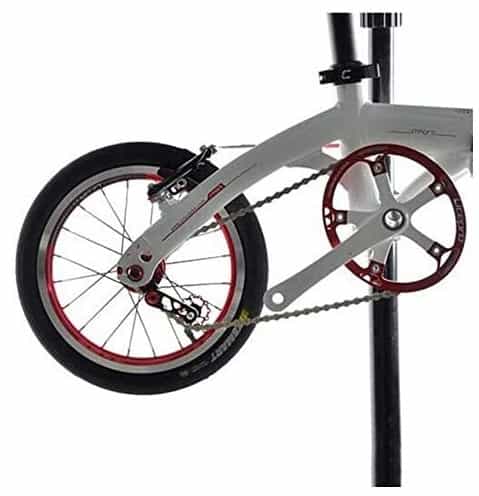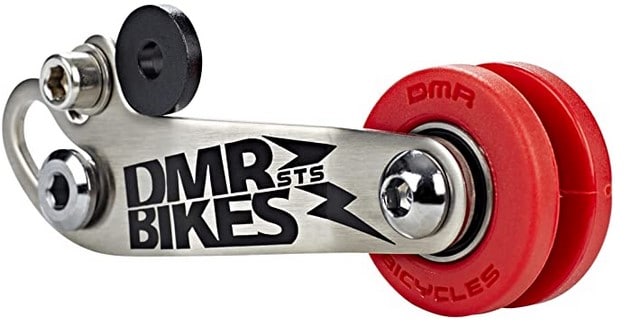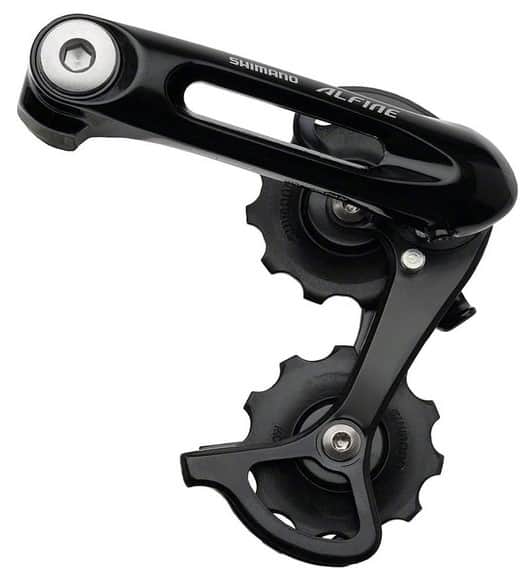Chain tensioners cost about $15-$25, which may not be much for most people, but if you are budget conscious like me, you’ve to wonder if they are worth it. So, are chain tensioners necessary?
Chain tensioners are necessary for converting multi-speed bikes into single-speed, especially those whose frames have vertical dropouts. Additionally, they are essential if the bike chain is too long or when you pedal hard, cycle daily, or want to extend the chain’s life.
On the flip side, a chain tensioner is unnecessary if the bike frame only has horizontal dropouts or you recently bought the bike, and its chain is in good shape.
Let me explain these arguments next. I’ll also share how chain tensioners work and how you can install them.
But first, let me help you understand what a chain tensioner does.

In a rush? Check out the best chain tensioners below:
But First; What Is A Chain Tensioner For?
A chain tensioner’s primary role is to adjust the chain’s tension. You can use it when the chain stretches or is just too long or when you want to convert your multi-speed bike into a single-speed.
Once you adjust the chain’s tension, it becomes easy to shift into different gears.
That happens typically through the tensioner’s puller and spring mechanism, which minimizes the chain’s tension when you shift and regains it when the bike shifts to your preferred cog.
Without this device, you may have difficulty changing the gears, and the chain is likely to drop off most times.
Are Chain Tensioners Necessary? If Yes, When?
As I hinted, a chain tensioner is only necessary for specific situations, which include the following:
a) During Multi-Speed to Single-Speed Conversions
Let’s face it, multi-speed bikes might be faster and more efficient, but they are generally heavier and hard to maintain.
Luckily, they are convertible into single-speeds with the correct single-speed conversion kit. One thing that doesn’t come with most conversion kits but is essential is the chain tensioner or Singulator.
Do you know why?
That’s because the chain loses its tension when you do the conversion, and a chain tensioner can help you restore it.
Remember, a multi-speed bike has a longer chain than a single-speed, and so the chain is likely to become loose once you convert the drivetrain.
While a chain tensioner is necessary for single-speed conversions, it doesn’t suit all kinds of bike frames. In particular, this device only serves bike frames with vertical dropouts to prevent the wheel from moving back and forth.

b) When the Chain is Long or Loose
Over time, bicycle chains wear out and stretch. If that happens, they become too loose and are likely to drop off often when you pedal.
A chain tensioner, however, ensures that such a situation doesn’t happen. The tensioner allows you to correctly adjust the chain’s tension and cycle as if the chain is new.
Note, however, that if the chain is too old, replacing it is advisable.
c) If You Intend to Ride Long-Term Daily
If you ride daily and have been doing it for some time and are not planning to stop anytime soon, a chain tensioner is worth getting.
That’s because the chain is likely to stretch and become loose over time. So, instead of rushing to get a new bike chain, you should consider getting a chain tensioner, which is cheaper than a new bicycle chain.
d) If You Like Pedaling Hard
Another possible cause of a chain stretch is hard pedaling. If you are an aggressive cyclist and want an effective way to maintain the chain’s tension, you should fit a chain tensioner.
Remember, the chain is also likely to misalign or fall off when you pedal hard. A chain tensioner, luckily, comes to the rescue in such a situation. That’s why an MTB chain tensioner is an excellent purchase for MTB owners.
e) Most Important Reason – Chain Tensioners Extend the Life of The Chain and Other Components
Since a chain tensioner gives the bicycle chain the correct tension and allows you to shift better, it reduces the risk of chain wear and, by extension, wear to other drivetrain components.
In the long run, that saves you money and allows you to use the chain and the drivetrain for longer.
When Are Chain Tensioners Not Necessary?
We’ve seen situations when a chain tensioner is necessary. Now, let’s talk about two cases where a chain isn’t required:
a) If the Bike Frame Has Horizontal Dropouts
While a chain tensioner is best for bike frames with vertical dropouts, it’s unnecessary for horizontal dropouts. That’s because such bike frames allow you to create some chain tension by sliding the rear wheel back, eliminating the need for a chain tensioner.
Note that there are two types of horizontal dropouts; track-ends and semi-horizontal.
Track-ends are present on track bikes, trial bikes, dirt jumping bikes, BMX bikes, and some MTBs.

Overall, frames with track-end dropouts are best for fixed-gear or single-speed conversions as they are safer and eliminate the need for chain tensioners.
Semi-horizontal dropouts, in contrast, are present on vintage road bikes. They are generally best for single-speed bikes because they allow you to slide the wheel back, mimicking the rear derailleur’s T-pulley chain tensioner.
As a result, they eliminate the need for chain tensioners.
Here’s the takeaway:
Longer dropouts (which in this case are horizontal dropouts) offer you more room to pull the rear wheel and adjust the chain’s tension. That eliminates the need for Singulators/chain tensioners.
b) When the Bike is New
If the bicycle is relatively new, the chances are that the chain fits nicely on the chainring and allows you to shift correctly. In that case, a chain tensioner is not necessary.
That’s unless you decide to change it into a single-speed or you accidentally fit a longer chain.
How Do Chain Tensioners Work?
Chain tensioners work through a pulley and spring system that enables them to reduce the chain’s tension when shifting into a different gear. The system also prevents the chain from slacking and falling off all the time.
Usually, a chain tensioner employs two types of pulley systems for its performance. First, there is the T-pulley, whose work is to adjust the chain’s tension, and second, there is a G-pulley that guides the bicycle chain into the cage.
Once you attach the chain tensioner to the drivetrain hanger, the T-pulley stretches the bike chain to give it proper tension.
How To Install Chain Tensioner Single Speed
The installation process for chain tensioners for single-speed conversions involves the following steps:
- Take out the axel-nut from the bike’s drive side
- Place the Singulator gently on the rear dropout
- Take the axel-nut back before tightening it as it was
- Shift the wheel into the frame dropout before adjusting the chain tension
- Position the rear wheel contrary as you continue adjusting the chain tension using the tensioner screw
- Lastly, re-secure the axel-nut as it was initially

FAQs
1. What Do Chain Tensioners Do?
Chain tensioners adjust the bike’s chain tension to allow you to pedal and more smoothly. They prevent chain slacking and vibrations, which improves the cycling comfort and the safety of doing it.
2. Is A Chain Tensioner Necessary?
A chain tensioner is only necessary for these scenarios:
- When you want to convert a multi-gear into a single-gear bike
- When your bike frame has vertical dropouts
- If you pedal hard
- If you cycle regularly and plan to do it long-term
But still, a chain tensioner is overall a good investment if you want to boost the life of your bike chain and drivetrain.
3. Do Fixies Need Chain Tensioners?
Not all Fixies require chain tensioners but only those with horizontal dropouts. The dropouts allow you to position the back wheel in a stable fixed position.
Additionally, the tensioner allows you to secure the axel onto the bike frame.
4. Do I Need A Chain Tensioner For A Single Speed?
If you plan to convert your multi-speed bike into a single-speed, then yes, you need a chain tensioner. The bike frame, however, has to have vertical dropouts to prevent the rear wheel from slipping.
5. Do You Need Chain Tensioner for Motorized Bike?
A chain tensioner is recommendable on motorized bikes to reduce the chain’s vibration and wear and allow you to shift smoothly. You, however, have to ensure you get a chain tensioner for a motorized bike.
6. Are Chain Tensioners Good?
Given that chain tensioners generally improve the chain’s life, they are good. These devices are also good because they allow you to easily convert your multi-gear into a single-speed bike and let you shift quickly.
Are Chain Tensioners Necessary? Closing Thoughts:
Generally, chain tensioners are primarily necessary when doing single-speed conversions or when the chain is stretched either due to wear or just a wrong long choice.
But like I mentioned, the fact that chain tensioners improve the chain’s life, you don’t need any other convincing reason to get it.